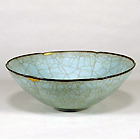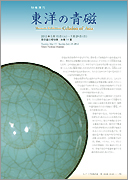Japanese Gallery (Honkan) Room 14
May 15, 2012 (Tue) - July 29, 2012 (Sun)
Celadon wares are ceramics unique to Asia. When unglazed pottery wares are fired in kilns, the ash from the fuel falls onto the surface of vessels and vitrifies into a natural glaze. The finding of this phenomenon led to the production of artificially glazed porcelain in China, as early as in the first half of the Shang dynasty (ca. 16th century BC). This production method, called ash glaze, underwent improvements to create celadon, a glaze presenting even and smooth blue colors.
Celadon ware reached a level of maturity during the Eastern Han dynasty. From then until the Yuan dynasty, it can be said that the history of Chinese ceramics developed around celadon ware. Celadon was also regarded as most prestigious in terms of cultural values. In the Song dynasty, imperial kilns were established to produce celadon ware for the imperial court.
The art of celadon ware then traveled to neighboring countries. Particularly in Korea, high technical sophistication was accomplished during the Goryeo dynasty (918-1392), and the distinctively transparent celadon from this time was prized for its color of jade. The blue color of celadon does not derive from a substance specifically added to the glaze. It comes from the miniscule amount of iron included in the clay or glaze, which is transformed by being fired in kilns, where the supply of oxygen is limited. Characteristics of celadon wares according to the site and period of production can be observed in their color and luster.
This exhibition introduces celadon from China, Korea, Vietnam, Thailand, and Japan. We hope visitors enjoy the beauty of celadon, which developed in styles unique to each region.


